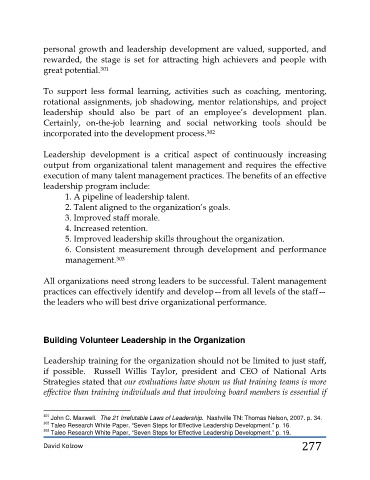Page 277 - 4- Leading_from_Within
P. 277
personal growth and leadership development are valued, supported, and
rewarded, the stage is set for attracting high achievers and people with
great potential. 301
To support less formal learning, activities such as coaching, mentoring,
rotational assignments, job shadowing, mentor relationships, and project
leadership should also be part of an employee’s development plan.
Certainly, on-the-job learning and social networking tools should be
incorporated into the development process. 302
Leadership development is a critical aspect of continuously increasing
output from organizational talent management and requires the effective
execution of many talent management practices. The benefits of an effective
leadership program include:
1. A pipeline of leadership talent.
2. Talent aligned to the organization’s goals.
3. Improved staff morale.
4. Increased retention.
5. Improved leadership skills throughout the organization.
6. Consistent measurement through development and performance
management. 303
All organizations need strong leaders to be successful. Talent management
practices can effectively identify and develop—from all levels of the staff—
the leaders who will best drive organizational performance.
Building Volunteer Leadership in the Organization
Leadership training for the organization should not be limited to just staff,
if possible. Russell Willis Taylor, president and CEO of National Arts
Strategies stated that our evaluations have shown us that training teams is more
effective than training individuals and that involving board members is essential if
301 John C. Maxwell. The 21 Irrefutable Laws of Leadership. Nashville TN: Thomas Nelson, 2007. p. 34.
302
Taleo Research White Paper, “Seven Steps for Effective Leadership Development.” p. 16.
303
Taleo Research White Paper, “Seven Steps for Effective Leadership Development.” p. 19.
David Kolzow 277

